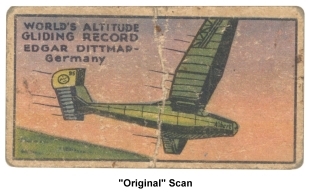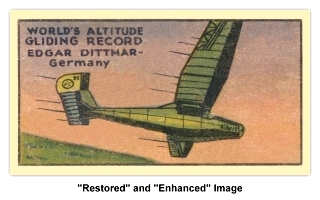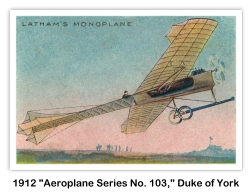
| ||||
|---|---|---|---|---|
 |
 |
 |
 |
 |



























| ||||
|---|---|---|---|---|
 |
 |
 |
 |
 |


























Trade Cards
A Collector’s Guide to Airplane Trading Cards
Card Collecting or “Cartophilia”
For the hobby of “Cartophilia”, there are two basic collecting categories: (1) Sports Cards and (2) Non-Sports Cards. We are all familiar with Sports Cards, the most famous being Baseball cards. Of course, sports cards run the entire gamut of sports, i.e. baseball cards, basketball cards, football cards, soccer cards, hockey cards, etc. However, many people do not realize that there is another major trade card category other than Sports Cards. The Non-Sports Cards category seems to include every other possible subject matter from A (i.e. Aeroplanes) to Z (i.e. Zoo Animals) and everything else in between. Retailers have used Non-sports Cards as an advertising media since the late 1800s. Every conceivable product has been advertised via non-sports cards. Examples include chewing gum, teas, tobacco products, food products, ice cream, breakfast cereals, etc.
Type Card collectors make up the majority of the non-sports card collectors. For example, our Skytamer Images collection is focused on vintage aviation and military cards to display on our website. Other collectors may specialize in WWII cards, vintage gum cards, automobile cards, movie-star cards, railroad cards, super-hero cards, ship cards, etc.
Prices of individual cards and/or sets range from just a few dollars, up to thousands of dollars. The card value depends on the condition and scarcity of the cards and/or sets. The easiest way to start collecting is to use eBay. You may also purchase cards via online card stores. Just decide what you want to collect and go for it!
Since 2002, Skytamer Images has been purchasing vintage aviation and military related non-sports cards to feature on our Skytamer.com website. We are currently in the process of populating our website with approximately 400+ non-sports card sets, mostly aviation related. Nearly all of the featured card sets include both original scans and computer enhanced hi-resolution (600+ dpi) scans of the fronts and backs of all the cards in the individual sets. We also include, when possible, printable PDF checklists for each of the card sets. By the way, when you print out these high-resolution card images on high-quality photo paper and trim them, they make great full-size Filler Card Images to use before you are able to acquire the real card. We should note that Skytamer Images is actually an Image Collector rather than a Card Collector per se. Once we have scanned a card for the Skytamer.com website, we have no further use for it, and eventually post it on eBay.
Overview
A Quick Note: The Non-Sports Card collections in this section are sorted alphabetically by set title. Use the A - Z navigation buttons at the top to view the various card collections.
The Airplane, Military, and Non-Sports Trading Card section of the Skytamer.com website focuses on Airplane Trading Cards, with a few other non-sport cards thrown in for good-measure. The card images presented in this section were obtained from original card scans from the Al Kramer Collection, the Bob Dros Collection, the John Shupek Collection (Skytamer Archive), and numerous high resolutions scans sent to us by fellow collectors. All of the images presented in this section have been computer enhanced/restored in an attempt to present the artwork in its original beauty. To this end, blemishes, creases, stains, spots and scratches were removed, borders whitened, card images re-centered, colors enhanced, etc. Examples of original and restored/enhanced card images are shown below.


Each card series contains a brief overview of the card series along with a checklist and high-resolution (600+ dpi) original scans of the fronts and backs of each card plus the computer enhanced/restored images. In many cases, we have been able to include high resolutions scans of the various set albums, and a few of the wrappers. The lofty-goal of this section is to provide a comprehensive compilation of aviation related trading cards, including checklists, wrappers, and high-resolution scans.
The cards in this section were issued worldwide, but mainly from the United States, the UK, Canada, Australia, New Zealand, and many other countries as noted. The cards cover a time-frame from approximately 1912 to the present. The original focus was on the “Gum” issues, however that quickly expanded to include tobacco, gum, cereal, confectionary, bakery, ice cream, foodstuffs, gasoline and gasoline/oil products, etc. Basically, if they card has something to do with aviation, and its does not have feathers, we’ve tried to included it.
A Little History About Trade Cards
In the early days of trading cards, they were used mainly as an advertising medium. The cards were inserted in the individual packages of the related products to enhance the customer base of the product, and of course to lure potential customers away from their competitors. The greatest use of trading cards were with the tobacco issues produced during the period from 1885 to 1891. Of course these cards were targeted at adult males who smoked or chewed tobacco. Later on, companies who manufactured and sold household goods, decided to target adult women for collector cards. This led to sets such as the Arm & Hammer “Birds” Series, and the Arbuckle Coffee sets. During this period, children really  did not have any purchasing power, so the collector cards were not targeted for their market.
did not have any purchasing power, so the collector cards were not targeted for their market.
Things changed when the “Penny Candy” and the “Caramel” cards sets were issued between 1907 and 1914. These cards sets were designed and marketed to attract both juvenile and adult sales. A typical early caramel card is shown below.
During the early days of card collecting, things were much different than in today. For example, there was no radio, or television to provide the instant images of world events that we’re so used to. The printed media was the primary source of information, and collector cards were a handy source of receiving information. Therefore, the heavy paper and cardboard collector cards became the source of both information and entertainment. During the early 1900’s, families would build up scrapbooks of clippings, collector cards, postcards, and any other type of printed media that reflected the world and society of the times. The insert cards of that era were just one of the many different items that were available to collectors. Most of the cards were selected by chance or at random. This was due to the lack of mass media and marketing as we have today.
During the late 1920s and early 1930s, everything changed with the development and introduction of “Bubble Gum”. Of course, children were to be the new key players as we entered the “Bubble Gum Age”. In 1933, the Goudey Gum Company of Boston introduced their “Indian Chewing Gum” and their “Big League Chewing Gum” sets of gum trading cards. Not only did these multi-color artwork cards have a fancy wrapper, they also included a large slab of tasty gum.
This was a brilliant move by the Goudey Gum Company. They “killed two birds with one stone”. They issued a psychological “slap in the face” to the Great Depression, and they challenged their competitors to “sink or swim”. This was the shot in the arm that the trading card industry needed to extract themselves from the psychological quagmire of the Great Depression. Needless to say, the Goudey Gum Company posted record sales. The sales were to kids, not adults! We had officially entered the Golden Era of the Bubble Gum Age, 1930 to 1960. Since 1960, the actual Bubble Gum issues have given way to stand-along collector cards. However, the basic size and style of the current collector cards remaining the same. Even though the present cards to not include gum, they will always be known as “Bubble Gum Cards”.
Types of Cards
There are three primary types of cards associated with card collecting: Advertising, Insert, and Souvenir cards.
Advertising Cards are cards given away or used solely for advertising purposes. They are not sold or paid for in any manner. The first type, which includes most of the smaller items, is often called Trade Cards since they were given to customers by the retail tradesmen or storekeepers. The second type, or Store Cards, were used within the stores as hangers, counter cards, banners, etc., and ranged up to several feet in length. While intended solely for store use, many have been saved and are highly prized by collectors. Trade Cards, in America, date back to Colonial dates.
Insert Cards were packed or inserted with a product and sold to the customer in that manner. They were obtainable only with some product such as cigarettes, coffee, or candy and are commonly referred to as cigarette cards, gum cards, etc., pending on their origin. They were made expressly to be collected and have always been popular with collectors. In some cases they were given in exchange for coupons that were packed with a product and so may take the form of albums or large-size items. Many were made of cloth or metal rather than cardboard. They were first used in the late 1870’s.
Souvenir Cards, generally speaking, are made to be sold because of their own intrinsic interest. All of them have an underlying practical use or purpose of differing natures, but to collectors is the subject matter of the illustration or design and the artistic elements which, aside from the historical aspects, have the primary appeal. Some of them have an advertising or gift complex, but usually retained much of their essential souvenir nature. The best known forms are picture postcards, playing cards, and greeting cards, but there are several others of considerable interest.
Obtaining Cards
While many collectors restrict themselves to a small segment of cards, the best advice is to collect general, as far as possible, as a wide interest means a wider circle of friends and increased enjoyment of obtaining the items more frequently. There are numerous dealers who specialize in card items, especially postcards, and hundreds of others to dealing antiques, old books, prints, curios, and other Americana. These people are constantly finding old forgotten collections and will be glad to help serious collectors. Auction buying and selling via eBay is probably the most efficient and effective method of buying and selling cards. Skytamer Images has acquired most of the cards presented on this site via from eBay. EBay has the added side-benefit of increasing your worldwide contacts of people that are interested in the same hobby. If you have never used eBay, give it a try.
Card Grading
As with any type of collecting, it’s always best to know the condition or grade of the collectable. To this end, the Professional Sports Authenticator (PSA) 10-point Grading Scale was developed as a guideline for grading trading cards. This standard was developed by a group of the nation’s leading trading card experts that recognized that in order for the trading card industry to realize its true potential, an industry-wide grading standard was needed. The PSA 10-Point Grading Scale, has developed into the standard for the industry and is accepted by professional trading card dealers, collectors, and leading auction houses.
Skytamer Images does not authenticate or grade cards. If you need to have your cards professionally graded, visit the Professional Sports Authenticator (PSA) website for details.
| Card Flaws | |
|---|---|
Centering is determined by comparing the measurements of the borders from left to right and top to bottom. The centering is designated as the percent of difference at the most off-center part of the card. A 5% leeway is given to the front centering minimum standards for cards which grade NM 7 or better. For example, a card which meets all of the other requirements for MT 9 and measures 60/40 off center on the front automatically meets the PSA front centering standards for MT 9. If a card meets all of the other requirements for MT 9 and measures 65/35 off center on the front, it may be deemed to meet the PSA front centering standards for MT 9 if the eye appeal of the card is good. Cards with centering below the minimum standards for the grade will be designated OC. For example, a PSA Mint 9 card which is more than 65/35 off center on the front would be graded Mint 9 OC. | |
| ST |
Cards with staining below the minimum standards for the grade are designated ST. |
| PD |
Cards with significant printing defects are designated as PD. |
| OF |
Cards with focus below the minimum standards for the grade are designated as OF. |
| MK |
Cards with writing, ink marks, pencil marks, etc. are designated as MK. |
| Ungradeable Cards - No Grade Definitions | |
|---|---|
If the grade of your card is available and is listed with one of the following grades, this card was determined to be ungradeable for the following reasons. | |
|
Evidence of Trimming: When a card’s edge has been altered, a card doctor may use scissors, scalpel, cutter, or any other cutting instrument. A trimmed card may exhibit one of the following: (a) Hook up or down, (b) Have one razor sharp edge, (c) A difference in toning along the edge, or (d) A wavy look. | |
| N-2 |
Evidence of Restoration: When a card’s paper stock is built up - for example, when ripped corners are built up to look like new corners. |
| N-3 |
Evidence of Re-coloration: Where a card’s color has been artificially improved. |
| N-4 |
Questionable Authenticity: This is the term used when a card is counterfeit. |
| N-5 |
Altered Stock: This term is used when the paper stock is altered in one or more of the following ways: Stretching and trimming, re-coloring and restoring, trimming and re-coloring, restoring an trimming, crease or wrinkle is pressed out, or gloss is enhanced. |
| N-6 |
Minimum Size Requirement: When a card is significantly undersized according to factory specifications. |
| N-7 |
Evidence of Cleaning: When a whitener is used to whiten borders or a solution is used to remove wax, candy, gum or tobacco stains. |
| N-8 |
Miscut: This term is used when the factory cut is an abnormal cut. |
